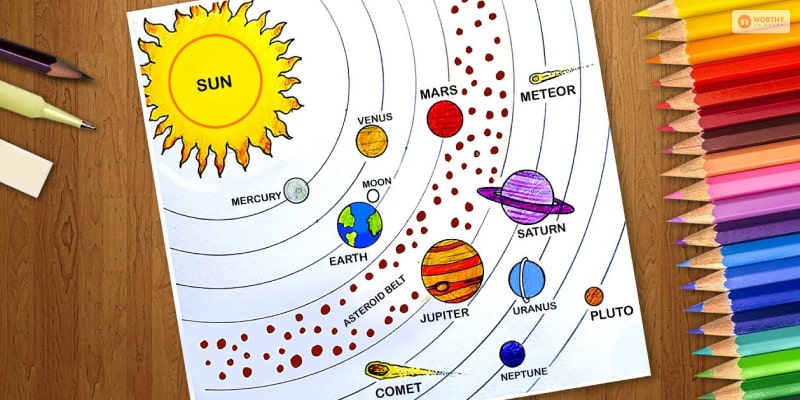Are you wondering how to draw the perfect solar system diagram? If yes, and you are planning to help your child with their school project, I have you covered!
We all were kids, and we had to go through the laborious task of sharpening our pencils and getting everything from erasers to the compass to draw the solar system. My friends, who knew more about how to draw things perfectly, even used shading pencils of varying darkness and thickness to make sure that they got straight A’s.
However, if you are someone who completely sucks at drawing but is hellbent on making sure that no one can laugh at your solar system, you have reached the right place. Keep reading till the end to learn more…
Solar System Diagram: How To Draw A Solar System?
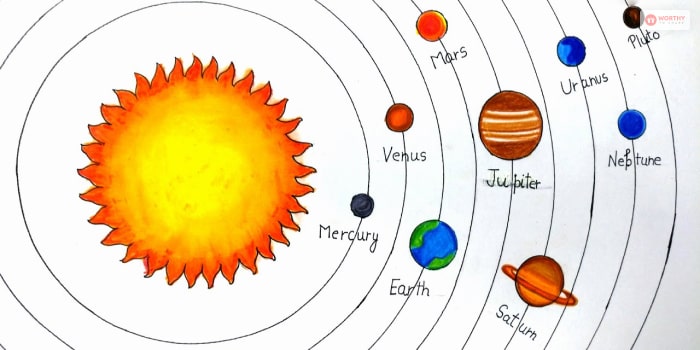
Solar system drawings are some of the basic diagrams that we all have to draw in school. While it might look easy in the beginning, most people get confused about the varying sizes of the planets and, most importantly, the placements of the orbits!
If you are someone who wants to nail the solar system diagram, you have come to the right place. Here is the guide that you need to draw the best solar system. Take a look at these steps to learn more:
1. Start With The Sun
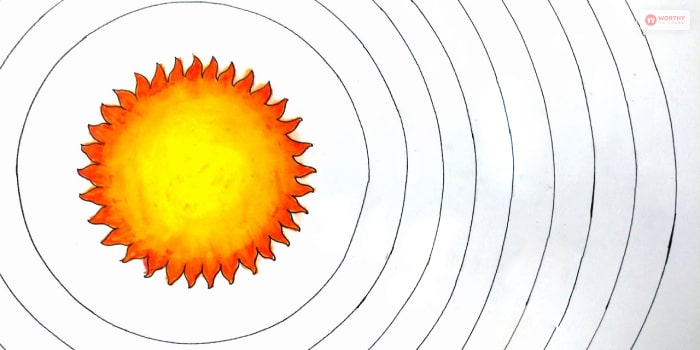
The first thing that you need to do is draw the Sun. It is the center of the solar system. No matter where you want to place the Sun, it is important that you keep in mind that there should be enough space around the Sun to place the planets.
If you are planning to color the solar system, take a colored pencil and color the Sun yellow. Don’t forget to shade it a little with orange to make it look the prettiest (and a realistic) Sun.
2. Place Mercury Close To The Sun

After you are done with the Sun, it is time to move on to the planets. The first one on the list is Mercury. It is the smallest planet and the one that is closest to the Sun. Make a small circle.
If you are planning to color it, make sure that you color it gray. The color of Mercury is slate gray. You can also use your pencil to lightly shade the planet.
3. A Slightly Bigger Circle For Venus
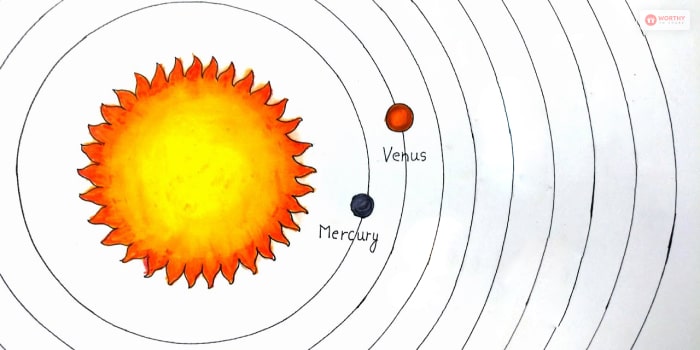
After Mercury comes Venus. It is the second planet in the Solar system and falls between Mercury and Earth. Draw a circle that is noticeably bigger than Mercury. Make sure there is some space between Mercury and Venus.
When it comes to coloring, it is very easy to color Venus. It is pearly white in color. However, due to the presence of sulfur dioxide, the color of the planet appears to be yellowish-white. So you might want to lightly use the yellow colored pencil to fill the insides of Venus.
4. Our Earth Comes Next
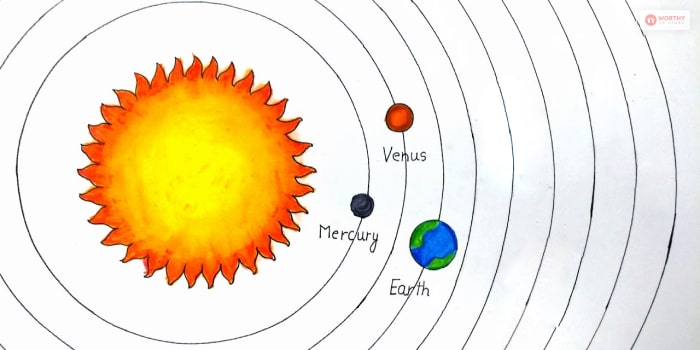
This is what we all have been waiting for! Erath is the third planet from the Sun in the solar system and one of the most beautiful planets to exist. It is the only planet (possibly) to have support life. And that is all because of the presence of water and oxygen. It is also placed at a great distance from the Sun, which makes it habitable— neither too hot nor too cold.
The size of Earth should be similar to Venus. And when it comes to coloring the planet, use blue and green. However, make sure that you are using more blue than green. This is because one-third of the planet is covered with water bodies.
5. Next Comes Mars

After Earth comes to the planet Mars. Being the fourth planet in the solar system, Mars falls between Earth and Jupiter. Because of the distance between the planet and the Sun, it has a much bigger elliptical path compared to the Earth. However, when it comes to the size of the planet, it is much smaller than our planet.
The planet is known to be the Red Planet. This is because of the rusty dust that lies suspended in the atmosphere of Mars. However, it is not a uniform red. So if you are planning to color the planet, make sure that you color it using brown and red pencils.
6. Draw A Bigger Circle For Jupiter
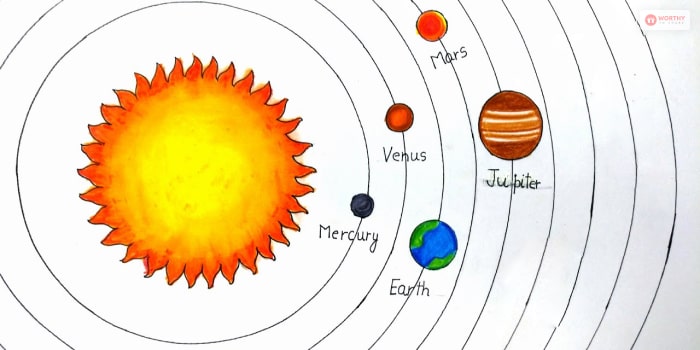
Next comes Jupiter, the largest planet in the solar system. It is a planet that is known for the sandstorms that are visible from space. When it comes to the placement of the planet, make sure that you are drawing the circle after keeping a considerable and noticeable gap from Mars.
The color of Jupiter, which has more than sixty moons revolving around it, is mostly beige. However, there are several stripes of dusty red and orange. So make sure that you are drawing the stripes when you are painting Jupiter.
7. Saturn Is Smaller, With Rings

Saturn comes next. Because of the distance from the Sun, Saturn has a much colder temperature than Jupiter and is also smaller in size. When it comes to the distance, it is located 9.5 Astronomical Units (AU) from the Sun. So make sure that you are able to place it right.
The color of the planet, from Earth, appears to be yellow-brown. The outer atmosphere of the planet is made of helium and hydrogen. The presence of ammonia, phosphine, hydrocarbons, and water vapor. This is the reason why it looks that way. So keep that in mind while you are painting the planet.
Do not forget to draw the rings around the planet. Keep in mind that these rings are actually the icy rocks that revolve around the planet. While drawing them, start with two lines that meet each other at the end. Keep the sides of the rings wider and the front part narrow. Make them grayish in color.
8. Sketch Uranus Next To Saturn
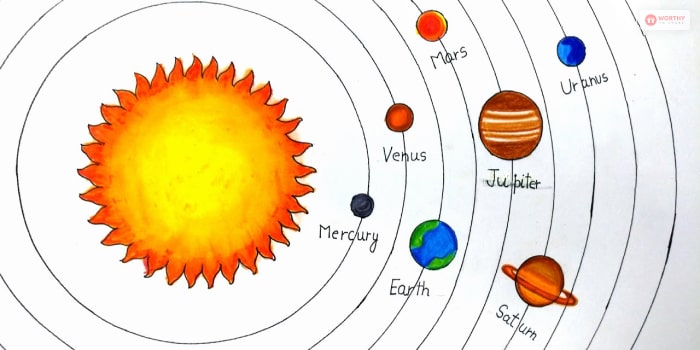
After Saturn, you need to draw Uranus. It is the seventh planet in the solar system and farther away from the Sun. Scientists have figured that the sunlight gets reflected from the top layer of the atmosphere of Uranus. This makes the planet a big chunk of ice.
Like Saturn, Uranus also has rings around it. You can draw a few rings spaced a little bit from one another. To avoid making the diagram messy, make sure that you draw not more than three rings. You can make them simple by drawing a semicircular line around the planet.
It is a planet that is filled with Methane. The gas absorbs the red portion of the sunlight, and this gives the planet a bright blue color. The actual color of the planet is described to be cyan, so make sure that you fill in the color, keeping that in mind.
9. Neptune Is Smaller

The last planet in the solar system diagram is Neptune. It is the planet that is farthest from the Sun. This is the eighth planet in the solar system and the last one. While Pluto was considered to be the ninth planet previously, it has now been reclassified as a dwarf planet. It is the fourth largest planet after Jupiter, Saturn, and Uranus.
This planet is yet another one that is blue in color. But it is rather a darker shade of blue compared to the bright blue color of Uranus. According to NASA, “The predominant blue color of the planet is a result of the absorption of red and infrared light by Neptune’s methane atmosphere.” So, keep this in mind while coloring the planet.
You also need to draw the rings around this planet. This is something that you need to keep in mind while drawing the planet. The color of the things can be a lighter shade of dark blue.
10. Finish It Off With The Orbits

The last step in creating the best solar system diagram is the orbits. These are the imaginary paths that are fixed, which the planets take in order to revolve around the Sun.
After you are done drawing all the planets, you need to start drawing the elliptical paths. The size of the orbits will increase from the first planet to the last planet. Mercury has the smallest or shortest orbit because it is the closest to the Sun. And, keeping this in mind, Neptune, which is the farthest from the Sun, has the longest orbit.
Significance Of Solar System For Children!
Children must learn about the solar system because it is important for them to learn about the sun, stars, planets and moon. Teachers must explain and guide students about the Solar system before they learn how to draw it. Both young and old children are quite curious about all things related to space.
What can be more interesting than the big expanse of the sky filled with twinkling stars. The curiosity children experience when they learn or read about the planets or the Sun. Further, it also helps for children to learn about Earth considering it is their planet afterall.
The information about Earth that is shared to the children is both valuable and unique. It is the children who need to learn why Earth should be kept healthy and safe. Knowledge about our solar system helps children to become more aware of technology and science.
Knowledge about space will help the children to learn about the importance of the solar system along with the different forms of water. Knowing about the ecosystem will help the children to establish a more practical knowledge about the solar system and the planets in it!
Wrapping It Up!
In case you were searching for the best ways to draw the solar system diagram and the best ways to draw one, I hope that this guide has been of help to you. Kindly feel free to ask any questions regarding the same if you have any.
Read Also:

